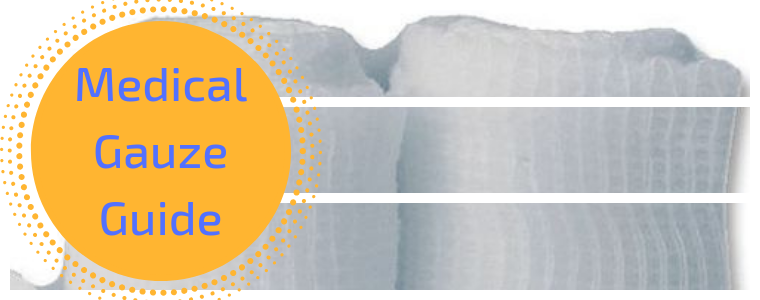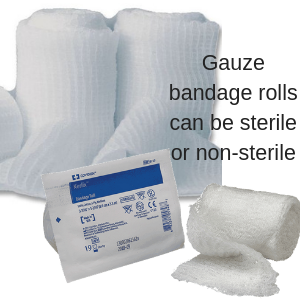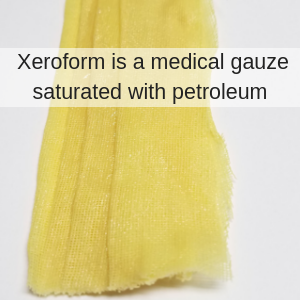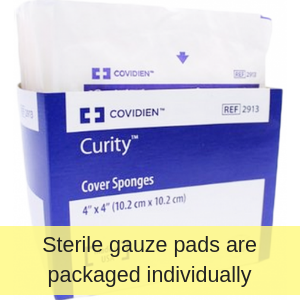Medical Gauze Guide

Content Updated: June 20, 2025
Gauze is a fabric that has many different uses, while medical gauze is specifically used in wound care. Gauze pads, bandage rolls, and other medical dressings all take advantage of the highly absorbent quality of gauze. It is a versatile product and can be used by itself or it can be saturated with petroleum like in Xeroform.
When it comes to medical gauze, you will have a lot of choices, so it is best to ask your doctor for a recommendation. If you are using medical gauze to treat an open wound, then you should make sure you are using sterile gauze. It is important that wounds are kept clean, and the best way to do that is to use sterile medical supplies.
Using sterile gloves instead of regular nitrile gloves can keep a sterile zone for your wound. Your medical supply store should have a selection of types of gauze, such as sterile gauze pads, bandage rolls, nitrile gloves, and wound cleansers. All of these can help you avoid infection.
What is Gauze Used For?
Gauze is a breathable, loosely woven material widely used in healthcare for its versatility in wound management and surgical procedures. Unlike occlusive dressings—which seal in moisture—gauze allows airflow, helping wounds stay clean and dry, which supports natural healing in many scenarios.
Primary Medical Uses
- Wound Dressing: Gauze protects the wound while allowing airflow, helping to promote healing.
- Fluid Absorption: It efficiently absorbs blood, pus, and other exudates.
- Dressing Support: Gauze often secures other dressings, helping them stay in place without disrupting the wound.
- Wound Packing: Its structure makes gauze suitable for packing deeper wounds to encourage healing from the inside out.
Additional Medical Uses
- Debridement: Coarser gauze may be used to gently remove dead tissue.
- Topical Application: Gauze can apply ointments or medications directly to wounds.
- Surgical Use: In operating rooms, gauze sponges are used to absorb fluids and maintain sterile fields.
Non-Medical Uses
Beyond clinical settings, gauze has a range of practical applications:
- First Aid at Home or School: It’s a go-to for quickly treating minor injuries.
- Cosmetic Use: Estheticians use gauze for facials and skincare treatments.
- Crafts and Industry: Gauze is valued in art, bookbinding, and industrial filtering or padding.
Whether for wound care or creative use, gauze remains a go-to solution thanks to its adaptability and gentle effectiveness.
Types of Gauze Dressings
There are two main types of medical gauze—woven and non-woven—each designed for different wound care needs. Understanding their differences helps ensure the right type is used for optimal healing and comfort.

Woven Gauze
Woven gauze is made from cotton fibers in a loose, open weave that allows wound fluids to pass through into more absorbent secondary dressings like pads or sponges. It is commonly used as a secondary dressing, not for direct application to open wounds. If cut, woven gauze can unravel, leaving lint or fiber debris that may delay healing. Its tendency to dry out wounds can make dressing changes painful and may damage delicate healing tissue. While affordable and widely available, woven gauze is best reserved for covering dressings rather than direct wound contact.
Non-Woven Gauze
Non-woven gauze is manufactured from synthetic fibers—typically polyester, rayon, or blends—that are pressed together into a tight, uniform pattern. This structure offers superior absorbency, wicking ability, and durability, making it suitable as a primary dressing. Non-woven gauze produces less lint than woven gauze, minimizing the risk of fibers being left behind in the wound. It’s also softer and less likely to stick to healing tissue, providing a more comfortable experience for the patient and reducing the chance of wound disruption during dressing changes. Its enhanced fluid retention makes it ideal for wound packing and use in clinical settings.
Different Styles of Medical Gauze

Petrolatum Dressings
These gauze dressings are coated or saturated with pharmaceutical materials, such as petroleum jelly, and they are used because they will not stick to wounds. They are also an occlusive dressing which means the dressing prevents air from reaching the wound. This will protect the wound from bacteria, and it can help medicine stay in place.
Antimicrobial / Impregnated Gauze
Impregnated gauze is a specialized form of medical dressing, designed to provide additional benefits to the wound healing process. These gauzes are saturated with various substances, such as medicine, oil, iodine, hydrogel, or antimicrobial agents like silver or iodine, which help to prevent bacterial infections in wounds. Impregnated gauze helps in the healing process, for example by improving absorption of drainage or reducing bacteria, which can play a significant role in preventing wound complications.
Gauze Rolls
Used for holding other wound dressings in place, gauze rolls can be wrapped around the body and secured with medical tape. They are also used to pad an injured area to increase comfort and protect tender wound sites. Most gauze rolls are not very absorbent which is why they are generally a secondary dressing. padding for comfort, and protection of tender wound sites. Gauze rolls can be cotton, elastic, or a nylon and latex mix, the pattern tends to be fluff dried with crinkle-weave. Most gauze rolls are not overly absorbent.
Gauze Pads
Gauze pads are also called gauze sponges, the terms can be used interchangeably, gauze sponges are not more absorbent, it is just another name for gauze pads. Gauze pads are folded into a square, the layers are then referred to as "ply". The ply level is how many layers the folded gauze creates, such as 8 ply or 12 ply. The higher the ply, the thicker the gauze square because it will have more layers. Gauze pads are available in sterile and non-sterile, if the gauze pad is going to be used in wound care then sterile is preferred. Gauze pads can be either woven or non woven and can come in a variety of sizes. The typical open weave of gauze helps absorb wound fluid as well as aiding in the cleaning of dead tissue from the skin. Pads like these can be made with a variety of materials and your medical professional will be able to tell you what kind of gauze pad your wound requires. Common sizes are 2" x 2", 3" x 3", and 4" x 4".
Conforming Gauze
Conforming gauze is a type of medical dressing designed to adapt to the contours of various body parts, ensuring a secure and comfortable fit. This flexibility makes it ideal for dressing wounds located on joints or other areas where movement is frequent, as it stays in place without restricting motion. The soft, pliable nature of conforming gauze also minimizes discomfort for the patient, making it a preferred choice for both acute and chronic wound management.
Sterile vs Non Sterile

In regards to wound care, sterile means that the product is individually packaged and is free from dirt, bacteria, or other living microorganisms. It is a totally clean product that can be used in the treatment of open wounds.
Non sterile gauze wound dressings or medical gauze should not be used on open wounds. They can be used for cushioning bruises or other types of closed wounds. Sterile gauze is going to be packaged to prevent the contents from being exposed to outside surfaces or dirt. If you would like your sterile gauze to stay as sterile as possible before you apply it to the wound then you will want to create a sterile zone.
To create a sterile zone, handle the gauze with clean hands while wearing sterile gloves. If you need to put the gauze down before applying it to the wound, only put it down on top of a new sterile drape. Once the sterile dressing comes into contact with a non sterile surface then it is no longer sterile. It takes patience and attention to detail to change wound dressings and this is why it should be left to a professional healthcare provider, unless you have been instructed on how to do it by your doctor.
Some types of wounds need specific care and they could need specific types of gauze as well.
Signs of Infection & When to all Your Doctor
Wounds can become infected which not only delays healing but it can also cause fevers and sickness. If you notice any of the following signs of infection, seek medical help and advice immediately.
- Redness expanding around your wound
- Increased swelling
- Increased levels of pain or tenderness
- Yellow, off-white, or green discharge draining from wound
- Change in smell, pungent and unpleasant smell emitting from the the wound
- Fever
The Integral Role of Gauze in Medical Care
Medical gauze plays an indispensable role in healthcare, from routine wound management to treating the surgical wounds of complex medical procedures. Its diverse forms, including standard, antimicrobial, impregnated, and conforming gauze, each cater to specific needs, enhancing patient care and aiding in the healing process. As medical technology advances, the fundamental importance of gauze remains constant, a testament to its effectiveness and versatility in the ever-evolving landscape of medical care.

